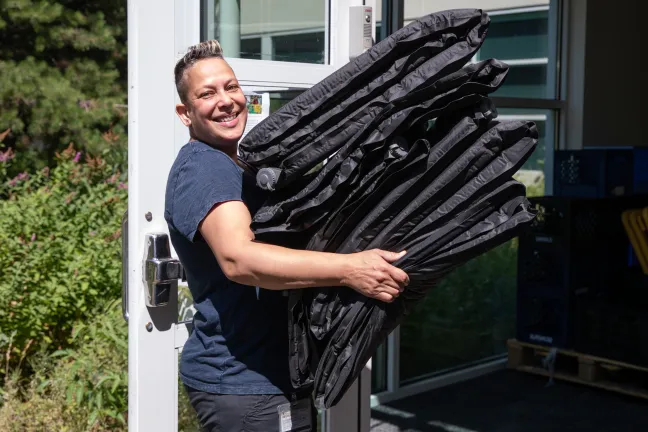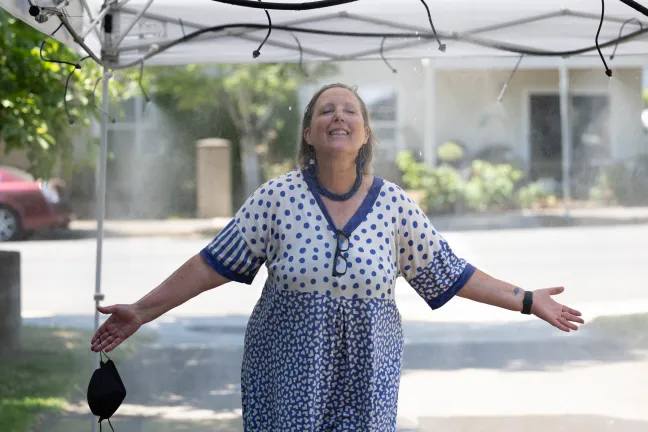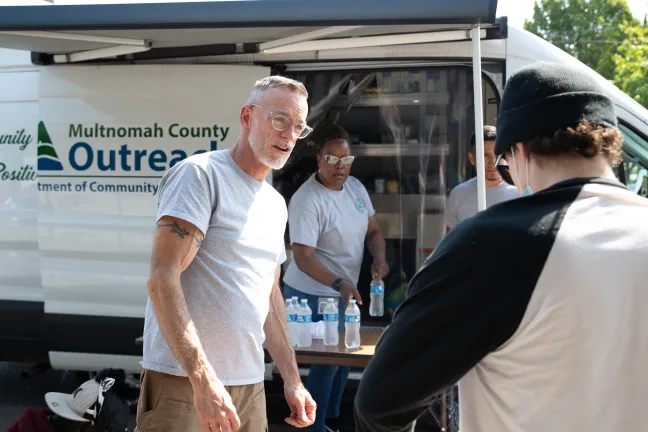After the longest stretch of extreme heat on record for our region, Multnomah County, the City of Portland and their community partners on Sunday, July 31, wound down a range of cooling services that served hundreds of people throughout one of the most severe heat emergencies the metro area has ever seen.
Multnomah County and Portland leaders both issued emergency declarations they were forced to extend. Temperatures reached or exceeded 95 degrees for seven consecutive days — setting a record for longevity and adding another grim climate milestone some 13 months after last June’s shorter heat dome shattered high temperature records and left 69 people dead.
The pair of deadly emergencies, coming so close together, highlight the harsh reality that severe climate change is drastically reshaping summer in the Pacific Northwest. The two events also underscore the ongoing need to prepare, both for local governments and residents.
Together, Multnomah County and Portland tapped their employees and community partners to support six days and five nights of 24-hour cooling shelters, the longest span in their history. They also offered day spaces, misting stations, transportation, and street outreach survival supplies. And they provided updates, safety tips, and targeted, urgent information in multiple languages
This year’s shared work sprang from strategies the County and City improved in the wake of last year’s heat dome and then tested during lesser bouts of heat last July and August. In the aftermath of this year’s heatwave, the City of Portland and Multnomah County will continue working together to conduct an after-action report, supported by a third-party contractor already on board, so they can identify and incorporate additional improvements into their response.
“Last year’s extraordinary heat sounded the alarm — climate change is happening now, in our own community, and these events will only return more frequently and with more intensity,” said Multnomah County Chair Deborah Kafoury. “After last year’s heat dome, we committed to identify and act on the lessons of that crisis. I’m grateful that our shared response this year was meaningfully informed by what we experienced last year, and it will certainly help us prepare for the inevitable next heat emergency.”
“What is clear at this time is that severe heat emergencies are becoming increasingly common in Portland,” said Portland Mayor Ted Wheeler. “This was an evolving weather event that required a unified and adaptable approach, one that we will continue with our County partners to ensure increased preparedness for the future.”
Cooling spaces and transportation
Four 24-hour shelters and a daytime cooling center opened Tuesday, July 26 — providing available space for 350-plus people each day, with capacity added as the heatwave both lingered and intensified beyond initial forecasts last week.
Those spaces ran from Tuesday afternoon through Sunday night, July 31, marking the longest run of cooling shelters and centers Multnomah County and its partners have ever provided.
At the same time, Multnomah County Library branches offered respite and water bottles, and extended hours at select locations, to people who needed help keeping cool. And for the first time, the City of Portland placed six misting stations and four 24-hour water-filling stations in parks throughout the community.
Hundreds of people came to shelters and day centers to escape the heat — whether to sleep, eat meals, drink water, take showers, get new clothing or even just read a book. Pets were welcome, with food and supplies provided by Multnomah County Animal Services. Guests also had access to behavioral health and medical services.
At their peak, the four 24-hour spaces hosted a high of 278 guests overnight on July 30. No one was turned away, and free transportation was available 24 hours a day. Separately, the Joint Office of Homeless Services provided additional shelter accommodations for dozens of people in families.
Workers and volunteers provided more than 150 rides to and from cool spaces, including for families and people using wheelchairs. Rides were dispatched through 211info, working with an expanded dedicated transportation team coordinated by the City of Portland. TriMet also waived fares for those who were traveling to cooling sites but couldn’t pay.
In all, nearly 250 County employees, along with more than a combined 220 City of Portland employees, State of Oregon employees and volunteers, supported that work and filled 1,183 shifts. Two service providers contracted with the County, Do Good Multnomah and Cultivate Initiatives, also contributed. Do Good Multnomah operated a daytime cooling center in Old Town, while Cultivate Initiatives operated the 24-hour Sunrise Center shelter.
“Our focus included 24/7 cooling shelters, daytime cooling centers, a robust communication strategy, extending hours at our libraries and ensuring we provided assistance to all that needed help during the highest temperature days,” said emergency management director Chris Voss. “The heat may have dissipated, but now is the time to prepare for the next event.”
Health impacts
Since the heatwave began Sunday, July 24, the City of Portland’s Bureau of Emergency Communications answered 184 heat-related 911 calls, with a peak of 40 calls on Saturday, July 30. During the week in June 2021 that included the region’s record-shattering heat dome, the Bureau answered 271 heat-related calls.
Emergency medical services were dispatched to 137 heat-related incidents Sunday July 24 through Sunday, July 31.
Emergency departments and urgent care centers treated 81 people for heat illness from Sunday, July 24, through Monday, Aug. 1. That’s close to the average number of heat-related visits for an entire summer.
The Multnomah County Medical Examiner’s Program reported seven possible hyperthermia deaths. Investigators say confirmation of the cause of death will not be complete for several weeks to months.
“We are grateful for the collaboration of so many community partners and the hard work of Multnomah County staff and volunteers over the unprecedented heat event,” said Dr. Ann Loeffler, Deputy Health Officer. “We are already evaluating our actions and outcomes with the goal of being prepared to keep our neighbors safe during these challenging times.”
Street outreach supplies
Even before the heatwave began, outreach teams and mutual aid groups started working to reach people in the community who are unsheltered.
Starting July 19, the Joint Office of Homeless Services’ downtown supply center opened to partners for appointments and distributed more than 145,000 bottles of water, 890 gallons of water, more than 3,200 refillable bottles of water, more than 7,800 cooling towels and nearly 16,500 electrolyte packets.
Organizations and programs such as Cascadia Behavioral Health’s Street Outreach Team, JOIN , Cultivate Initiatives, Multnomah County’s Department of Community Justice Mental Health Mobile Unit and the Multnomah County Sheriff’s Office HOPE Team made contact with people in the community, providing supplies and information about cooling locations and resources.
“I want to send appreciation to the outreach teams and community partners who worked every single day during this emergency, in the elements, and actually for several days before the heat arrived, supporting unsheltered neighbors all across Multnomah County,” said Shannon Singleton, interim director of the Joint Office. “They checked on people, and helped them get to cooling sites if that’s what they wanted. But for those who didn’t want to go, or weren’t able, they brought incredibly vital survival supplies like water, electrolytes and cooling towels. Their dedication made a difference.”
Contacting vulnerable residents
Early this summer, Multnomah County’s Environmental Health Division contacted operators of 300 multifamily buildings whose residents would be most at risk during a heatwave, offering information on how to check on residents, help residents stay cool and get to cooling spaces
As the heatwave lingered and threatened to grow even more dangerous, Chair Kafoury on Friday, July 29, worked with the County’s Health Department and the Portland Housing Bureau to ensure another round of outreach to people living in affordable housing.
The Health Department worked with the Housing Bureau to provide basic — but potentially life-saving — guidance to the bureau’s portfolio of housing operators and owners. Affordable housing providers, because of their direct connection to tenants, offer a critical link to thousands of renters with low incomes who include some of the most vulnerable people in our community.
At the same time, Chair Kafoury and Molly Rogers, interim Portland Housing Bureau director, personally called executive directors, emphasizing the need to share this information immediately. The Health Department also provided a direct contact for all housing providers.
“This was our longest string of 95-degree days in recorded history. And people might have felt like, ‘It’s hot. We get it!’ But when we look at what works, communicating the danger of heat is the single most effective strategy to keep people safe,” said Andrea Hamberg, interim director of the Environmental Health Division. “So in addition to all the general messages, we did even more targeted outreach based on the people we lost in the summer of 2021. That meant more multifamily outreach, calls to property owners, monitoring indoor temperatures at affordable housing complexes, geo-targeted outreach in areas with less tree cover and more multifamily properties, texts to all our WIC clients.
“And our short-term emergency response is not going to solve this problem. We need to do everything we can to reduce global warming, and we need to do everything we can to provide longer-term solutions to the people who are most at risk.”
Friday’s calls followed several other steps during the heatwave to directly reach vulnerable residents.
On Thursday, July 28, the City of Portland and Multnomah County issued more than 425,000 calls and text messages to Multnomah County residents associated with heat islands and other higher-risk parts of the community. Earlier in the week, nearly 10,000 calls and text messages were also made directly to residents in mobile home communities.
”We know the community gets information from many sources, including traditional news media, social media, and talking to their family and friends,” said Shad Ahmed, director of the Portland Bureau of Emergency Management. “By using the alert system, we were able to reach people who may have been missed through other means to share heat safety information with the community in English and Spanish.”
Providing air conditioners for vulnerable clients
Before the heatwave, Multnomah County’s Department of County Human Services continued its ongoing work to install air conditioning units in the homes of vulnerable clients, as part of a long-term effort to better prepare clients with lower incomes and live in urban heat islands.
That work continued even during the heatwave, including 37 installed over the weekend when temperatures were at their hottest, for a total of 129 air conditioning units installed. Those units are part of a spring purchase of about 180 units.
“Teams worked tirelessly to get cooling units in the homes of our clients with the highest heat risk,” said Lee Girard, the interim deputy director for the Department of County Human Services. “It’s clear these efforts made an immediate difference for those who needed them the most.”
Currently, this service is only available to clients of the County’s Aging, Disability and Veterans Services and Intellectual and Developmental Disabilities divisions.
Hundreds more units are on the way: The Board of Commissioners voted in June to approve one-time funding that will allow County Human Services to purchase and install up to 1,000 units during the 2022-23 fiscal year that started July 1. The County has begun ordering units with these funds and expects the first order to arrive this month, barring any supply chain issues.



